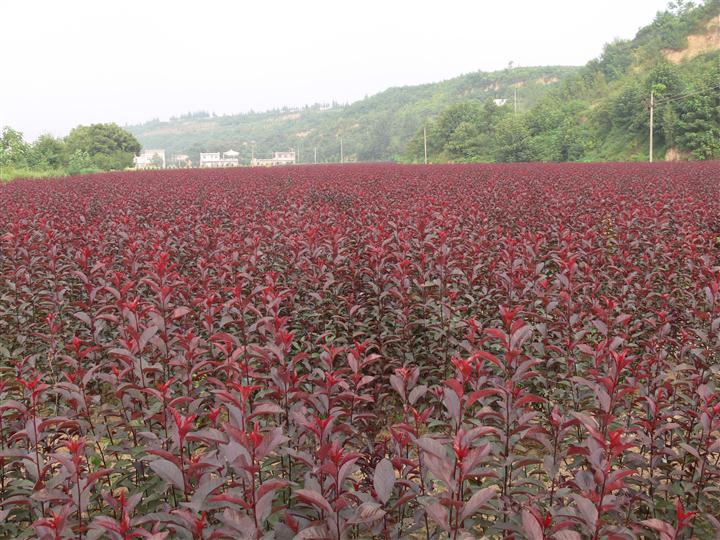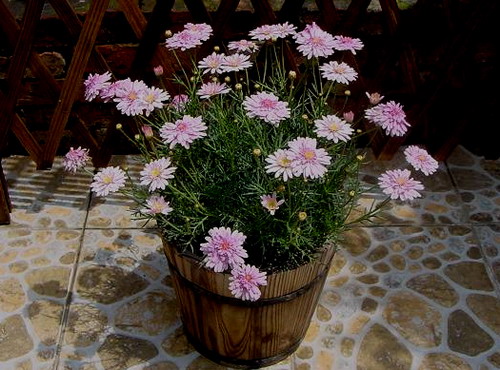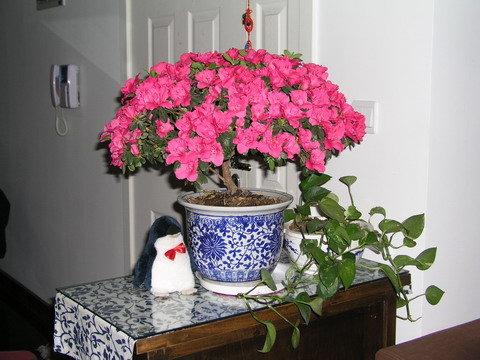Culture methods and points for attention of Purple Leaf Dwarf Sakura
Reproduction method
Cuttage propagation
In the solar greenhouse, make a seedbed 120 cm wide along the east-west direction or north-south direction, with a cutting substrate 8-10 cm thick, lay peat soil on the bottom layer, then fully mix vermiculite powder and perlite and rake flat on it. The cutting substrate was used according to the ratio of vermiculite powder: perlite: peat soil at 2:1:1. After that, plug-in or suspended micro-spraying equipment is installed above the seedbed, with a micro-spray radius of 70 cm.
The branches were cut from a robust mother branch with a diameter of 0.3 cm to 0.8 cm. After the branches were collected, they were placed in a cool, wet place or wrapped in a moist material to avoid water loss, and then cut into cuttings of 10 cm to 12 cm, each cuttings retained 4 × 6 bud nodes. Cut flat at the upper end of the bud node 2 cm, and cut the lower end close to the back of the bud into a 45 °oblique cut □. In order to improve the rooting rate of cuttings, cuttings 30~60min can be soaked in α-naphthylacetic acid 500~800mg/ kg solution or abt rooting powder 200~500mg/ kg solution.
Purple leaf dwarf cherry should be cut from late November to early December, that is, 20 days after the leaves completely withered. The depth of cuttings is 1 cm / m ~ 2, the distance between cuttings is 2.5 ~ 3.5cm, and the suitable cutting depth is 1000 / m ~ 2. After cutting, the substrate is watered with spray. During the cutting period of 20-40 days, the air humidity should be kept at 70%-80% and the temperature should be kept at 15-28 degrees Celsius, so as to facilitate the formation of callus at the base of cuttings and promote the rooting of cuttings. After 40 days and 50 days, due to the gradual formation of new roots, attention should be paid to the harm of black spot to cuttings. 70% methyl thiophanate wettable powder 700 times 800 times or 50% carbendazim wettable powder 600 times 800 times solution was sprayed every 15 days; in order to make the seedlings grow healthily, 2.0g/ kg potassium hydrogen phosphate solution was sprayed every 7 days. When the root system of the seedling reached 10-15 cm at 100-120 days after cutting, it could be transplanted and planted.

Grafting propagation
The seedlings of mountain peach and mountain apricot, which are compatible with scions and free of diseases and insect pests, were selected as rootstocks and planted according to plant spacing of 30 cm and row spacing of 50 cm. After survival, purple leaf dwarf cherry was grafted.
The grafting method of purple leaf dwarf cherry is mainly used. It is suitable for grafting when the branches of purple leaf dwarf cherry have not germinated and the sap begins to flow from March to April. When cutting the scion, the scion must be cut at about 3 cm from the first bud at the bottom, cut obliquely into a duck-bill shape on both sides of the bud, keep 3-5 buds up, keep the scion length 8-10 cm, then cut flat at 5 cm from the ground, split or cut according to the thickness of the scion, the cambium of the scion must be closely docked with the cambium of the rootstock, and finally tie the graft □ with plastic strips. After the whole row of grafting is completed, a small arch shed is built to keep the scion from losing water and striping. Culture methods and matters needing attention of Purple Leaf Dwarf Sakura
Latin name Prunus × cistena
Binomial method Prunus × cistena
The plant kingdom.
Phylum angiosperm
Dicotyledonous class
Mu Qiang Wei Mu
Family Rosaceae
Belong to Prunus
Species of purple leaf dwarf cherry (purple leaf plum × dwarf cherry)
Distribution area: provinces and regions of the Yangtze River Basin
Purple leaf dwarf cherry (scientific name: Prunus × cistena), Rosaceae, Rosaceae deciduous shrubs or small trees, is a hybrid of purple leaf plum and dwarf cherry, widely distributed in China. The plant height is 1.8 m to 2.5 m, the crown width is 1.5 m to 2.8 m, the branches are purple-brown when young, and the old branches have lenticels. Flowers solitary, light pink, petals 5, slightly fragrant, florescence 4 ~ 5 months. Purple leaf dwarf cherry has good ornamental effect, fast growth, simple reproduction, resistance to pruning and strong adaptability. Purple leaf dwarf cherry generally uses grafting and cutting propagation, grafting rootstocks generally use mountain apricot, mountain peach, apricot rootstock is the best. It has strong sprouting and tillering ability, can be easily cultivated into balls or hedges in garden cultivation, forms multi-branches by picking hearts many times, cuts off miscellaneous branches before winter, and makes heavy truncation of overgrown branches, which is ornamental with cultivation.
1. Morphological characteristics.
Purple leaf dwarf cherry is a deciduous shrub or small tree, about 2.5m high, with a crown width of 1.5 m to 2.8 m. Branches purple-brown when young, usually glabrous, old branches lenticellate, distributed throughout the branch. Leaves long ovate or ovate long elliptic, long 4~8cm, apex acuminate, leaf base widely cuneate, leaf margin with irregular fine obtuse teeth, leaf surface red or purple, back color more red, new leaf tip bright purplish red, current year branch xylem red, flowers solitary, medium small, light pink, petals 5, fragrant, stamens numerous, single pistil, florescence 4-5 months.
2. Growth habits
Sunny purple leaf dwarf cherry is a light-loving tree species, but it is also cold-tolerant and shade-tolerant. If you plant in areas where there is not enough light, the leaves will turn green, so you should plant them in places with sufficient light.
Culture methods and matters needing attention of golden banyan Chinese name Huangjinbong
Latin name Ficus microcarpa cv.GoldenLeaves
Also known as yellow leaf banyan, yellow heart banyan
The plant kingdom.
Phylum angiosperm
Dicotyledonous class
Kosanko
Belong to the genus Ficus
Distributed in Taiwan, South China, Southeast Asia and Australia
Golden banyan (Ficus microcarpa cv. Golden Leaves), also known as banyan, Moraceae, evergreen shrub, heat-resistant, humid, barren but not shade-tolerant, foliage, bonsai tree species. Strong tillering ability, golden leaves, easy to shape, widely used in gardens, often used as street trees, landscape trees, green hedges. The name of golden banyan comes from the fact that the leaves are golden green. Evergreen trees or shrubs, up to 25m high, crown broad umbrella-shaped, width up to 30m, branches with drooping air roots. Leaves alternate, Obovate to elliptic, 4-10cm long, leathery, entire. Flowers unisexual, monoecious, cryptic inflorescences. The fruit is globose and red when ripe.
1. Morphological characteristics.
Small evergreen tree with broad crown and much branched trunk. The single leaf is alternate, the leaf shape is oval or Obovate, the leaf surface is smooth, the leaf edge is neat, the leaf is shiny, the tender leaf is golden yellow, and the old leaf is dark green. Globose cryptocephalic inflorescences with clusters of male and female flowers. Parasitic wasps often infect the fruits of Moraceae.
2. Growth habits
Prefer a semi-overcast, warm and humid climate. It is cold-resistant, can withstand a short-term low temperature of 0 ℃, grows faster when the temperature is 25-30 ℃, and is easy to produce air roots when the air humidity is above 80%. Like the light. But avoid direct glare. Strong adaptability, exuberant growth, easy modeling, few diseases and insect pests, general soil can be cultivated. Is a tropical tree species, China from south to north, as the temperature drops, the tree shape also decreases accordingly, in the north of South China, generally only 20 meters high, breast diameter 150 cm.
3. Distribution range
Golden banyan is found in tropical and subtropical Asia, in Taiwan and South China, as well as in Southeast Asia and Australia.
4. Cultivation techniques
A place that is hot, humid and sunny. Sexual preference for high temperature and humidity, less diseases and insect pests, wind resistance, moisture resistance, strong resistance to air pollution. Poor soil can be planted as long as the soil is fertile and sunny.
Cutting propagation can use seeds to raise seedlings. Cutting is carried out after the temperature rises in spring, it is easy to survive, old branches or twigs can be used as cuttings, can be cut into a long section of about 20 cm, can also be cut into a length of about 1 meter, directly inserted into the nursery. Keep it moist, root in about 1 month, stay in the nursery for 2-4 years, and then come out of the nursery for planting in the open field. Can also be used about 2 meters long, about 6 centimeters in diameter of the rough, cut off the branches and leaves, the top wrapped in mud, without raising seedlings, directly cut into the dry planting.
Cultivate pile scenery, dig more old trees on the stone mountain, and then carry out horticultural processing after planting and surviving. The seed seedlings were used more and more, and the fruit matured in October, November to January of the following year and other seasons. After the fruit is harvested and piled up, it is put into a tight cloth bag and rubbed and bleached in water to get the seeds. The weight of a thousand seeds is about 0.4 grams, and the germination rate varies from year to year, up to 40%. In some years, seeds do not germinate. Seeds should not lose water and should be stored in wet filter paper or mixed with fine sand or sowed with picking. According to the sowing requirements of small seeds, the seeds are first sown on the sowing plate or in a meticulous and flat garden to prevent the impact of rain. It can germinate in about 1 day, can be transplanted to nursery in about 2 months, and can be planted in nursery in 2-5 years old. The seedling has soft branches and developed root system, which is suitable for various shapes such as curved stem, leaning joint, root lifting and so on, and the crown should also be trimmed into various forms.
The common pest of disease and pest control is gray silkworm moth. Grey silkworm moth larvae feed on leaves and shoots, low instar larvae bite mesophyll and older instar larvae eat leaves. Because the larvae have mimicry phenomenon, it is not easy to be found, and it is easy to cause great harm. The nymphs and adults of thrips suck up the sap of the young leaves and buds of the host, resulting in purple-red-brown spots of different sizes, the shoots wither and the leaves fold to the front along the midvein to form dumpling-like galls.
Control measures: imidacloprid, cypermethrin, deltamethrin and phoxim and other organophosphorus pesticides were mixed and sprayed.
5. Main value
Ornamental value is dense branches and leaves, crown expansion, is a good tree species of street trees and shade trees in South China, can become the main scene of lawn greening, can also be planted in the highway sub-belt green space, resistant to pruning, can be molded into a variety of color landscape. It can also be mixed with other foliage herbs, such as green amaranth to form a moving color contrast. It has the function of cleaning air, shade, scenery and so on.
Application value Young trees can bend their stems and lift their roots to make a variety of shapes to make art bonsai. Laodan can be trimmed into an ancient vigorous pile scene, and it is one of the most widely used tree species in horticulture. It can also be pruned intensively from infancy and trimmed into a spherical or wide oval crown year by year.
Bonsai is of high value and suitable for display in exhibition halls, museums, high-end hotels and so on. Big trees have strong ability to resist harmful gases and soot, so they should be planted in street trees, industrial and mining areas, squares, forest parks and so on. An ancient banyan can provide shade for hundreds of people.
The rapid development of modern gardens is reflected not only in the continuous rise of greening indicators, but also in the continuous improvement of greening level. In the new century, people have higher and higher expectations for environmental improvement. The so-called greening means to use green plants to change the appearance of the city, the purpose is to improve people's living and working environment. Because the color list of tree species in the past was all green, it was said to be "green". The monotonous feeling of green has become more and more unsuitable for the requirements of our colorful era. The characteristics of trees include tree shape, color and other factors, which constitute the characteristics of tree species and can resonate with people, which is the development value of color tree species. For example, blue makes people quiet, red makes people unrestrained, orange makes people enthusiastic, and different colors are embedded together, which will make people feel rich and colorful. The aesthetic value of the color of plants is obviously higher than that of pure green.
Simple plant flowers and colors are very attractive, but "flowers are not red for a hundred days", and the flowering season of plants is short. Colored tree species refer to the leaves or stems and branches of trees showing yellow, red, purple, orange-red, gray, silver-gray, white or mixed colors. At present, many color tree species have been born, such as purple leaf Berberis and purple leaf dwarf cherry, spring color tree species such as Toona sinensis, winter color tree species such as Robinia pseudoacacia, red rosewood, autumn color such as maple, money, etc., multi-season color such as Robinia pseudoacacia, golden leaf acacia, golden leaf acacia, color coniferous tree species and so on.
We pay more and more attention to the quality of living environment, not only greening, but also colorful. The tree species listed in this paper can meet this requirement and can be used in street greening, scenic spots, forest parks and so on. Color tree species have new leaves in spring, gorgeous flowers in summer, rich fruits in autumn and colorful branches in winter. no matter how the seasons change, color tree species are always an eye-catching highlight.
On the basis of the greening of local tree species, efforts should be made in the development of colored tree species. The development of color tree species in China started relatively late, many tree species have not been applied on a large scale, and the suitable growth range of most tree species is not clearly defined, so they should be introduced scientifically on the basis of regional tests.
- Prev

Culture methods and points for attention of Marguerite flowers
Margaery Chrysanthemum, Chrysanthemum morifolium, here is the experience of raising Marguerite, sorted out for reference. Soil, Marguerite likes loose, fertile, well-drained soil. Soil: 5 black mountain soil and 5 peat soil. If there is no black mountain soil, you can use garden soil instead. Cuttings
- Next

What should we pay attention to when growing flowers in winter?
In winter, raising a few pots of flowers and plants can not only purify the air, but also increase the vitality of the room, making your room and living room full of spring and pleasing to the eye. However, due to the low temperature and humidity in winter, the heated room is extremely dry, and the unheated room is very cold, which is disadvantageous to the growth of flowers and plants.
Related
- Fuxing push coffee new agricultural production and marketing class: lack of small-scale processing plants
- Jujube rice field leisure farm deep ploughing Yilan for five years to create a space for organic food and play
- Nongyu Farm-A trial of organic papaya for brave women with advanced technology
- Four points for attention in the prevention and control of diseases and insect pests of edible fungi
- How to add nutrient solution to Edible Fungi
- Is there any good way to control edible fungus mites?
- Open Inoculation Technology of Edible Fungi
- Is there any clever way to use fertilizer for edible fungus in winter?
- What agents are used to kill the pathogens of edible fungi in the mushroom shed?
- Rapid drying of Edible Fungi

